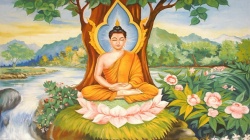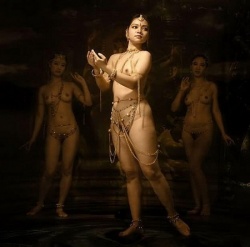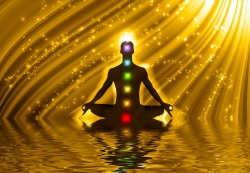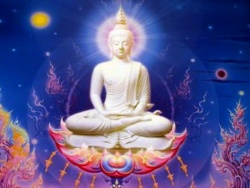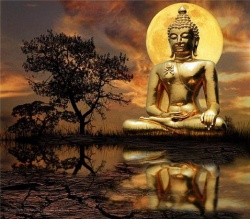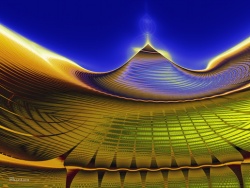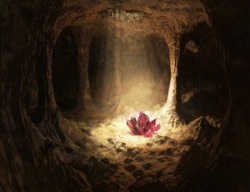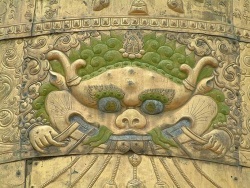The Legend of Shambhala
Rumors and reports have been in existence, for millennia now, that somewhere near or beyond Tibet, among icy peaks and in some of the secluded valleys of Eurasia, lies a "paradise", inaccessible to us. It is a place of enlightenment, wisdom and peace, called Shambhala, known by several other names such as "Shangri-La" and "Agharta."
Shambhala is a Sanskrit word, which means "place of peace." It has often been thought of as a cluster of minds, of perfect and semi-perfect beings, who are guiding the evolution of humanity. It is also considered to be the source and safeguard of Kalachakra (The Wheel of Time), one of the highest branches of Tibetan mysticism and Buddhism's teachings.
According to the legends, The King of Shambhala (Shambhala's existence predates Buddhism) travelled to India to meet Buddha and learn the Kalachakra teachings. He then took those teachings back to the Kingdom, where the teachings have been preserved. It is said that only a person with a pure heart can live in Shambhala. There, they shall enjoy ease and perfect happiness and will not know suffering, desire or age. Love and wisdom reign. Injustice and vices are unknown. The inhabitants are long-lived, wear beautiful and perfect bodies and possess supernatural powers; their spiritual knowledge is deep, their technological level highly advanced, their laws mild and their study of the arts and sciences covers the full spectrum of cultural achievement, but on a far higher level than anything the outside world has attained.
By definition Shambhala is hidden. Of the numerous explorers and seekers of spiritual wisdom who attempt to locate Shambhala, none can pinpoint its physical location on a map, although all say it exists in the mountainous regions of Eurasia. Many have also returned believing that Shambhala lies on the very edge of physical reality, as a bridge connecting this world to one beyond it.
Tibetan lamas spend a great deal of their lives in spiritual development before attempting the journey to Shambhala. Perhaps deliberately, the guidebooks to Shambhala describe the route in terms so vague that only those already initiated into the teachings of the Kalachakra can understand them.
According to some lamas, "As the traveller draws near the kingdom, their directions become increasingly mystical and difficult to correlate with the physical world. At least one lama has written that the vagueness of these books is deliberate and intended to keep Shambhala concealed from the barbarians who will take over the world." This line being referred to is from the Prophecy of Shambhala.
The Prophecy of Shambhala
The prophecy of Shambhala states that each of its kings will rule for 100 years. There will be 32 in all, and as their reigns pass, conditions in the outside world will deteriorate. Men will become more warlike and pursue power for its own sake, and an ideology of materialism will spread over the earth. There will then be a gradual deterioration of mankind as the ideology of materialism spreads over the earth. When the “barbarians” who follow this ideology are united under an evil king and think there is nothing left to conquer, the mists will lift to reveal the snowy mountains of Shambhala. The barbarians will attack Shambhala with a huge army equipped with terrible weapons. Then the 32nd king of Shambhala, Rudra Cakrin, will lead a mighty host against the invaders. In a last great battle, the evil king and his followers will be destroyed.
Some put the year of the prophecy as 2029, although most predictions put it at 2424, when a Great War will begin in India.
The Subterranean World of Agharta
Early European travellers to Tibet consistently told the same tale of a hidden spiritual center of power. The only difference, that these spoke of Shambhala being a hidden world underneath the surface of the planet. It was sometimes spelt Agharti, Asgartha or Agarttha), although it is now commonly known as Shambhala and often confuse travellers. I use the word "Agharta" here to identify the subterranean version of Shambhala.
Taking the legend in its most basic form, Agharta is said to be a mysterious underground kingdom situated somewhere beneath Asia and linked to the other continents of the world by a gigantic network of tunnels. These passageways, partly natural formations and partly the handiwork of the race which created the subterranean nation, provide a means of communication between all points, and have done so since time immemorial. According to the legend, vast lengths of the tunnels still exist today; the rest have been destroyed by cataclysms. The exact location of these passages, and the means of entry, are said to be known only to certain high initiates, and the details are most carefully guarded because the kingdom itself is a vast storehouse of secret knowledge. Some claim that the stored knowledge is derived from the lost Atlantean civilisation and of even earlier people who were the first intelligent beings to inhabit the earth.
It has been told that Agharta is a hidden land somewhere in the East, below the surface of the earth, where a population of millions is ruled by a “Sovereign Pontiff”, who is assisted by two colleagues, the “Mahatma” and the “Mahanga”. His realm was transferred underground and concealed from the surface-dwellers at the start of the Kali Yuga, which he dates around 3200 BCE. According to Saint-Yves, the “mages of Agarttha” had to descend into the infernal regions below them in order to work at bringing the earth’s chaos and negative energy to an end. “Each of these sages accomplishes his work in solitude, far from any light, under the cities, under deserts, under plains or under mountains.” Now and then Agharta sends emissaries to the upper world, of which it has perfect knowledge.
Agharta also enjoys the benefits of a technology advanced far beyond our own. Not only the latest discoveries of modern man, but the whole wisdom of the ages is enshrined in its libraries. Among its many secrets are those of the relationship of soul to body, and of the means to keep departed souls in communication with incarnate ones.
To Saint-Yves, these superior beings were the true authors of Synarchy, and for thousands of years Agharta had “radiated” Synarchy to the rest of the world, which in modern times has chosen foolishly to ignore it. When the world adopts Synarchical government the time will be ripe for Agharta to reveal itself.
Until the start of the twentieth century, the legend of Agharta remained very much... a legend. Stories of Agharta had widely spread in Europe but evidence to support the claims remained as elusive as ever. Indeed, it might well have been expected that in the rational and materialistic new century, such stories would finally be confined to the realms of fantasy: a colourful tradition to be ranked alongside other ancient mysteries such as the lost continents of Atlantis and Mu.
But such a supposition did not allow for the remarkable discoveries of two intrepid explorers who in the 1920s went into the vastness of Asia and there unearthed evidence about Agharta which far exceeded that of any previous reports. Their accounts, indeed, became the cornerstone of our present knowledge of the secret kingdom. One made his discoveries about Agharta while fleeing for his life from the Bolsheviks in Russia; the other came shortly after from self-imposed exile in America, seeking to penetrate the mysteries of Tibet. Their names were Ferdinand Ossendowski and Nicholas Roerich.
The King of the World - Ossendowski's Story
Russian traveller Ferdinand Ossendowski said he noticed there were times in his Mongolian travels when men and beasts paused, silent and immobile, as though listening. The herds of horses, the sheep and cattle, stood fixed to attention or crouched close to the ground. The birds did not fly, and marmots did not run and the dogs did not bark. “Earth and sky ceased breathing. The wind did not blow and the sun did not move…. All living beings in fear were involuntarily thrown into prayer and waiting for their fate.”
“Thus it has always been,” explained an old Mongol shepherd and hunter, “whenever the King of the World in his subterranean palace prays and searches out the destiny of all peoples on the earth.” For in Agharta, he said, “live the invisible rulers of all pious people, the King of the World or Brahatma, who can speak with God as I speak with you, and his two assistants: Mahatma, knowing the purposes of future events, and Mahinga, ruling the causes of those events. He knows all the forces of the world and reads all the souls of mankind and the great book of their destiny.”
As he fled through “Mysterious Mongolia... the Land of Demons,” he paused frequently to speak with Buddhist monks and lamas about the traditions associated with lakes, caves and monasteries. There was one story he said he encountered everywhere in Eurasia: he called it the “Kingdom of Agharti”, regarding it as nothing less than “the mystery of mysteries.”
He was also told of the miraculous powers of the Tibetan monks, and the Dalai Lama in particular – powers that foreigners could scarcely begin to appreciate. “But there also exists a still more powerful and more holy man… The King of the World in Agharti.”
Interestingly, Ossendowski reports that the enormous powers the people of Agharta were believed to control could be used to destroy whole areas of the planet, but equally could be harnessed as the means of propulsion of the most amazing vehicles of transport. It has been suggested that this could be a prediction of nuclear energy and flying saucers!
The Sign of Shambhala - Roerich's Story
Roerich too, maintained a diary of thoughts, from which we find the following: In August the shrine was consecrated in a solemn ceremony by a number of notable lamas invited to the site for the purpose, and after the event, writes Roerich, the Buriat guides forecast something auspicious impending. A day or two later, a large black bird was observed flying over the party. Beyond it, moving high in the cloudless sky, a huge, golden, spheroid body, whirling and shining brilliantly in the sun, was suddenly espied. Through three pairs of binoculars the travellers saw it fly rapidly from the north, from the direction of Altai, then veer sharply and vanish towards the southwest, behind the Humboldt mountains.
One of the lamas told Roerich that what he had seen was “the sign of Shambhala,” signifying that his mission had been blessed by the Great Ones of Altai, the lords of Shambhala. They had also been witness to a classic UFO, twenty years before the “official” beginning of the phenomenon with Kenneth Arnold’s sighting in 1947.
Roerich’s account of such a sighting aroused great interest in Europe and brought to the West the first concrete evidence that there might be something present in Eurasia that defied understanding. Victoria LePage describes its significance as such:
In its vivid colour and factuality, its bizarre but unarguable reference to an unknown golden aircraft that behaved as no ordinary airplane could, the Roerich story could rightly be called the first reliable intimation that the kingdom of Chang Shambhala was perhaps knowable as more than an intellectual curiosity, a popular Asian fable… and from about 1927 onward the world centre in the northern mountains exerted on Western occult circles the fascination of an idea whose time has come.
Which brings us to the very nature of reality. Paranormal experiences, including UFO sightings, are always indicative of an altered state of consciousness that allows the witness to see other realities. Often the experience is similar to a lucid dream, where ordinary space-time physics no longer applies.
What Shambhala Looks Like
For an idea as to what the Shambhala Kingdom looks like, we must delve slightly into Tibettan Buddhist mythology. Mount Meru is a place which simultaneously represents the center of the universe and the single-pointedness of mind sought by adepts. Thousands of miles in height, Meru is located somewhere beyond the physical plane of reality, in a realm of perfection and transcendence. Symbolic representations of Mount Meru are commonly found in Tibetan mandalas, contemplative diagrams designed to aid meditators in focusing.
It is said that Meru has its roots in hell, and its summit in heaven. Meru is surrounded by seven rings of golden mountains, each separated from the other by one of seven circular oceans. It is crowned by a golden palace wherein Indra, king of Hindu gods, resides. This entire superstructure rises from an outer ocean, and is flanked by four main continents, each with two subcontinents.
The southern continent, Jambudvipa, corresponds to the physical earth. Each of the other continents represents a nearby planet upon which transmigrating souls following the yellow light-path may be reborn. However, it is said that all of these worlds are undesirable, for they are non-human worlds inhabited by sheep, cattle, or horses. The teachings of Buddhism clearly state that existence as a human being is the only way to achieve Buddhahood, so rebirth in any other form (including that of a deva or demigod) is a distraction from the path to enlightenment.
According to legend, somewhere in the northwest region of Jambudvipa lies a land called Shambhala. This is a magical land which is shaped like an eight-petalled lotus flower. It has been ruled by priest-kings for many thousands of years; in fact, the legend of Shambhala predates the introduction of Buddhism into Tibet. In the aboriginal Bon religion, Shambhala is known as Olmolungrung, and is based on the square instead of the circle.
Shambhala forms a gateway between the physical and spiritual realms. It is endowed with riches, and is ideally suited for the habitat of enlightened souls. They are not attached to the fruits of karma, and are but one step from Buddhahood. This is the realm to be sought for rebirth if one desires the swiftest path to nirvana.
Finding Shambhala
Many western explorers, hearing tales of a "golden city" of Shambhala, sought to find it in the frozen wastes of northern Tibet. This resulted in the present-day term "Shangri-la," which, like El Dorado, signifies an unattainable goal. This is an unfortunate misunderstanding, for ultimately Shambhala is a place accessible to anyone, if only one can be free of karmic attachments.
While people (especially Tibetan lamas) have been searching for Shambhala for centuries, those who seek the kingdom often never return, either because they have found the hidden country and have remained there or because they have been destroyed in the attempt. Tibetan texts containing what appear to be historical facts about Shambhala, such as the names and dates of its kings and records of corresponding events occurring in the outside world, give Tibetans additional reason for believing that the kingdom exists. Recent events that seem to correspond to the predictions of the mythic kingdom add strength to their belief. The disintegration of Buddhism in Tibet and the growth of materialism throughout the world, coupled with the wars and turmoil of the 20th century, all fit in with the prophecy of Shambhala.
The Nazi Connection
Even Hitler was intrigued with the idea of Shambhala. Hitler was quite mystic-minded. In his youth, he studied the occult and yoga in Vienna, and received initiation into the American Indian peyote cult. Later he turned to Theosophy. He was invited to join an occult group in Germany, called Ultima Thulli, which planned to take over Germany. This later became the Nazi Party.
Once Hitler assumed power, one of his ministries was that of Ancestral Memories, headed by the Chairman of the Sanskrit Department at Munich University. It controlled the concentration camps. Through this connection with Sanskrit studies, the Nazis adopted the swastika, an ancient Indian symbol of immutable good luck. "Swastika" is a Sanskrit word that means well-being or good luck. It has appeared as a symbol throughout the Hindu, Buddhist, and Jain worlds for thousands of years. Hitler hoped it would likewise bring him good fortune.
Hitler gathered information about as many of the occult groups of the world as he could. His aim was to find the elements common with Theosophy and to reinterpret these teachings in terms of its theory. With the help of the explorer Sven Hedlin, he sent several expeditions to Tibet. They were searching for contacts with Shambhala to obtain their help for ruling the world. They claimed that although Shambhala rejected them, they were able to contact and gain help from the mystic kingdom of Agardhi that Blavatsky had mentioned. Before the main Nazi leaders were executed after the Nürenberg trials, it was reported that the leaders held an unknown religious ceremony led by a man with the keys to Agardhi.
Conclusion
The Eastern mystical view of the world can be quite different from the Western scientific view of it. It maybe that the guidebooks to Shambhala are describing a landscape transformed by the visions of a yogi taking the journey there: Where we would see a mountaintop gleaming with snow, he would see a golden temple with a shining god. In that case, we might be able to travel the same path, but with a different view of reality.
To travel to Shambhala is to undertake at one and the same time an inner mystical journey and an outer physical one through desolate and mountainous territory to a cosmic powerhouse.
An old Tibetan story tells of a young man who set off on the quest for Shambhala. After crossing many mountains, he came to the cave of an old hermit, who asked him, “Where are you going across these wastes of snow?”
“To find Shambhala,” the youth replied.
“Ah, well then, you need not travel far,” the hermit said. “The kingdom of Shambhala is in your own heart.
Source
mankindmysteries.blogspot.com.au [[Category:Shambhala[[File:|thumb|250px|]])]
